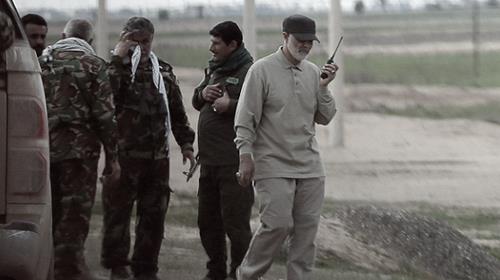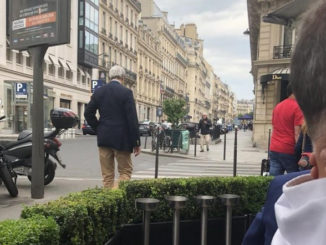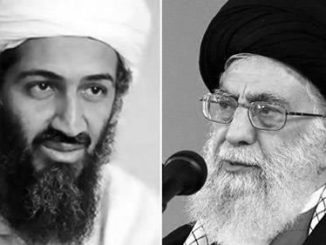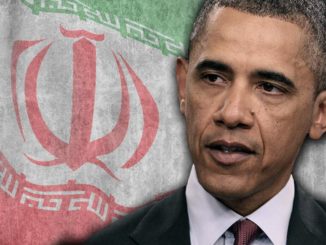
BY: Heshmat Alavi – Al Arabiya, 23 October 2017: Despite all the brouhaha made over Iran’s “lightning” advances in Iraqi Kurdistan, the entire scene change in less than 48 hours.
Tehran desperately needed to respond to US President Donald Trump’s lambasting October 13th speech launching a major policy shift and designating the Iranian regime’s crown jewel, the Revolutionary Guards (IRGC), as a terrorist organization.
The man thought to be Soleimani appears at about three seconds into the video, wearing a neckerchief.
The flag representing the Kurdistan Regional Government (KRG), brought down by Iran-backed militia forces known as the Popular Mobilization Forces (PMF), was raised once again Wednesday night.

Despite the tens of thousands of locals who fled their homes, footage on social media showed armed residents stationed in the streets of Kirkuk, Khaneqein and a number of other cities.
With locals taking matters into their own hands, and international pressure escalating on Baghdad, Iraqi Prime Minister Haider al-Abadi ordered all armed forces other than local security units to withdraw, forcing the PMF to retreat.
This is literally a slap in the face for Tehran.
Conflicting Reports
Rumors and various reports stream out of Iraqi Kurdistan on a constant basis. Reports indicate forces loyal to the Kurdistan Democratic Party led by KRG President Masoud Barzani arresting a number of ISIS commanders in the town of Hawija.
Further reports claim of these ISIS units coordinating attacks with Iran’s Quds Force and its commander, Qassem Soleimani. In this regard, allegations have been raised accusing the PMF of launching attacks targeting Kurdish areas aimed at releasing these very ISIS commanders.
As always, rumors and allegations are endless. Without a doubt, however, is the fact that the Iran-backed PMF units, considered Tehran’s “national treasure” in Iraq, have been forced to withdraw from Kurdish cities.
Many reports of these units attacking Kurdish homes, plundering people’s property and even setting their residents on fire were posted in the mere 48 hours of their presence in these cities. PMF units are known to have committed similar crimes in Sunni Arab cities following their cleansing of ISIS forces.
The United Nations expressed its worries and Washington called an end to all clashes and disputes.
The Iranian opposition National Council of Resistance of Iran issued a statement strongly condemning the IRGC’s “aggression and occupation,” adding Suleimani had been “plotting for it in Sulaimaniya and Baghdad and other areas of Iraq.”
Iran’s True Colors
The actions of Iran’s IRGC and the Quds Force in Iraqi Kurdistan, parallel to Suleimani’s presence, made Tehran’s deceitful role and intentions crystal clear for all parties.
Various outlets have accused the Patriotic Union of Kurdistan (PUK), defragmented following the death of former leader and Iraqi president Jalal Talibani, of signing behind-the-curtain deals with Iran.
Suleimani has been in Kurdistan for at least two weeks and there are rumors of Talibani’s family agreeing to stand down in the face of PMF units entering Kirkuk and other Kurdish regions.
Iran, of course, has not remained silent and used its influence in an attempt to save face and make further threats. The Iraqi judiciary issued an arrest warrant for PUK Deputy Director General Kosrat Rasul. In contrast to Iraqi Kurdish politician Barham Salih and members of the Talabani family who expressed their gratitude for Iran’s “support” of the Kurds, Rasul described the events taking place in Kirkuk as an occupation, going on to accuse certain figures of becoming Tehran’s 5th column.
There are now even reports heard of the Iraqi judiciary summoning Barzani himself to a court of law on charges of threatening Iraqi security, illegal oil smuggling, along with other administrative and legal violations.
America Steps In
There is word of senior Trump administration officials contacting al-Abadi, threatening military action if the PMF refuses to withdraw from Kurdish cities. Rumors also indicate Moscow made similar threats, as all parties sense the dangers of a fresh round of military conflict in Iraq playing into the hands of the all but completely annihilated ISIS, and more importantly Tehran.
Fresh in the minds of all parties are scenes of PMF units staging attacks on Sunni communities, committing atrocities against entire towns and villages. Such an outcome would only play into the hands of Iran as the sole benefactor of increasing turmoil in Iraq.
The Big Picture
Without a doubt the expansion of PMF units across Iraq, and as a result the IRGC Quds Force’s influence in this very important stretch of land, has raised eyebrows and concerns in Washington.
The PMF is specifically seeking to occupy certain areas to facilitate the land bridge sought by the Quds Force between Tehran and Damascus, stretching to Lebanon and the shores of the Mediterranean. With such means the Quds Force would enjoy the ease of providing necessary arms and equipment for the Lebanese Hezbollah, and beyond.
As various forces enter and exit the restive cities of northern Iraq, efforts are also underway to launch talks between Baghdad and the KRG capital, Erbil.
Iraqi President Foad Masoum, himself a Kurd, has been travelling between these two cities in attempts to have al-Abadi and Barzani agree to sit for negotiations. Al-Abadi was also recently the guest of Saudi King Salman in a visit to Riyadh that certainly caught the attention of Tehran.
“We are open and we want to move away from the past,” he said in the Saudi capital. “The region cannot tolerate any further divisions. Interference in the internal affairs of other state should stop.”
Looking Forward
Iraq will be holding general elections next year and al-Abadi is currently under pressure from two Shiite fronts.
Tehran-backed elements led by former Prime Minister Nouri al-Maliki have long been planning their return to power. Supporters of Muqtada Sadr, a Shiite cleric distancing from Iran and establishing closer ties with Saudi Arabia, is seeking to institute his position. It is a very high probability – and a nightmare scenario for Tehran – that Sadr may ally with secular Shiites led by Iraqi Vice President Ayad Allawi, alongside a number of Sunni groups to establish a coalition government.
The developments in Kurdistan have raised the intensity level in Iraq. Iran understands very well that the fall of the ISIS will allow the US and international community to focus on the main element threatening the entire region.
As explained in a White House press release prior to US President Donald Trump’s landmark October 13th Iran policy speech:
• Over the last decade and a half, United States policy has also consistently prioritized the immediate threat of Sunni extremist organizations over the longer-term threat of Iranian-backed militancy.
• In doing so, the United States has neglected Iran’s steady expansion of proxy forces and terrorist networks aimed at keeping its neighbors weak and unstable in hopes of dominating the greater Middle East. Recently, the Iranian regime has accelerated the seeding of these networks with increasingly destructive weapons as they try to establish a bridge from Iran to Lebanon and Syria.
• The Trump Administration will not repeat these mistakes.
Iran sought to recover following the IRGC’s terrorist designation by the US Treasury Department under Trump’s orders. With its supported units forced to withdraw from Kurdish cities, this crusade has not only backfired, but transformed into yet another slap in the face for Tehran’s rulers.
These major developments have sparked major diplomat efforts, as US Secretary of State Rex Tillerson has launched a trip to the Middle East, with a first stop in Riyadh and making a call for Iranian “militias” to leave Iraq.
Analysts view this as a Washington push to establish a Saudi-Iraq alliance aimed at countering Iran’s regional belligerence.




